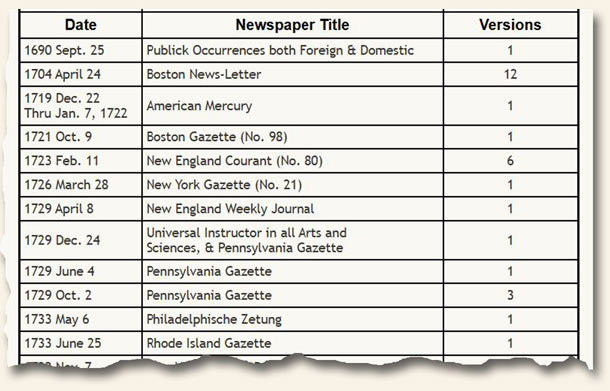You can’t always believe what you read… even when penned with good intentions…
May 6, 2024 by GuyHeilenman · Leave a Comment
(sarcasm alert)
Did you know you can obtain (collect) British newspapers older than the oldest known British newspapers?
While sounding a tad ridiculous, a newspaper article from a reliable 19th century publication confirms this claim.
Proof:
We recently discovered an article in an issue of the highly respected Niles’ National Register from 1839 which contained the following article: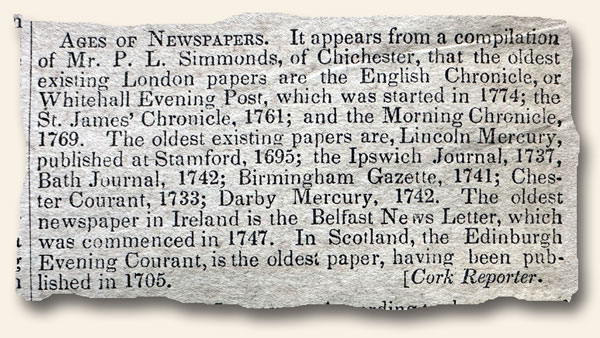
It appears that as of 1839, the oldest known “English” newspapers were from 1695. The problem? We have several to offer dated earlier. One might argue ours were discovered after this article was penned in 1839, but many of what we have are from The Times (London) whose claim to fame is being the oldest continuously published newspaper in England – perhaps the world(?), and was one of the more prominent newspapers from the 1600’s-1700’s. While the journalist may have been well-intentioned, the facts emphatically betray his/her research.
However, if you are one to believe everything you read, feel free to take a gander at…
British Newspapers Older than the Oldest British Newspapers
“Collecting Newspapers – The Basics” (Part V) – Reprints…
April 5, 2024 by GuyHeilenman · Leave a Comment
While “fakes” in collectibles, depending upon the item being sought (stamps, coins, Hummels, etc.), can be common, thankfully such is not the case with Rare and Early Newspapers. Furthermore, the common “fakes” (called “reprints”) are well documented and were rarely done with nefarious motives. Part of the reason for the rarity of reprints is likely the price-point of most collectible newspapers (still quite low) in comparison to the cost of creating a fake which would be good enough to pass as authentic to someone who is familiar with the collectible. Printing methods, ink, paper, era-specific (“tell-tale”) environmental impact, and more have varied so significantly over time, the cost and effort it would take to create profitable forgeries cost/effort prohibitive. Still, there are exceptions – and being “in the know” can save one from being duped out of their hard-earned savings.
The issue-specific attributes which help to distinguish a reprint from an authentic issue would fill a book to rival Tolstoy’s War and Peace – making an attempt to do so within a single post absurd. However, over the past decade we have created over a dozen posts in an effort to cover as much as possible – specifically targeting the most common. Hopefully you will find them helpful:
POSTS REGARDING COMMON REPRINTS
“Collecting Newspapers – The Basics” (Part III) – Newspaper Care…
December 11, 2023 by GuyHeilenman · Leave a Comment
We, (Timothy Hughes Rare & Early Newspapers), have been collecting and offering old and historic newspapers to the collecting community since 1976 (Tim’s first purchase was in 1975). For those who are either unfamiliar with or new to this amazing hobby, today we are kicking off a series of posts, “Collecting Newspapers – The Basics”, to serve en masse as a Primer for those interested in learning more about the collectible. This is the 3rd installment. Enjoy.
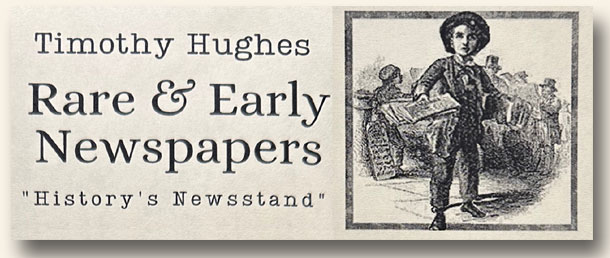
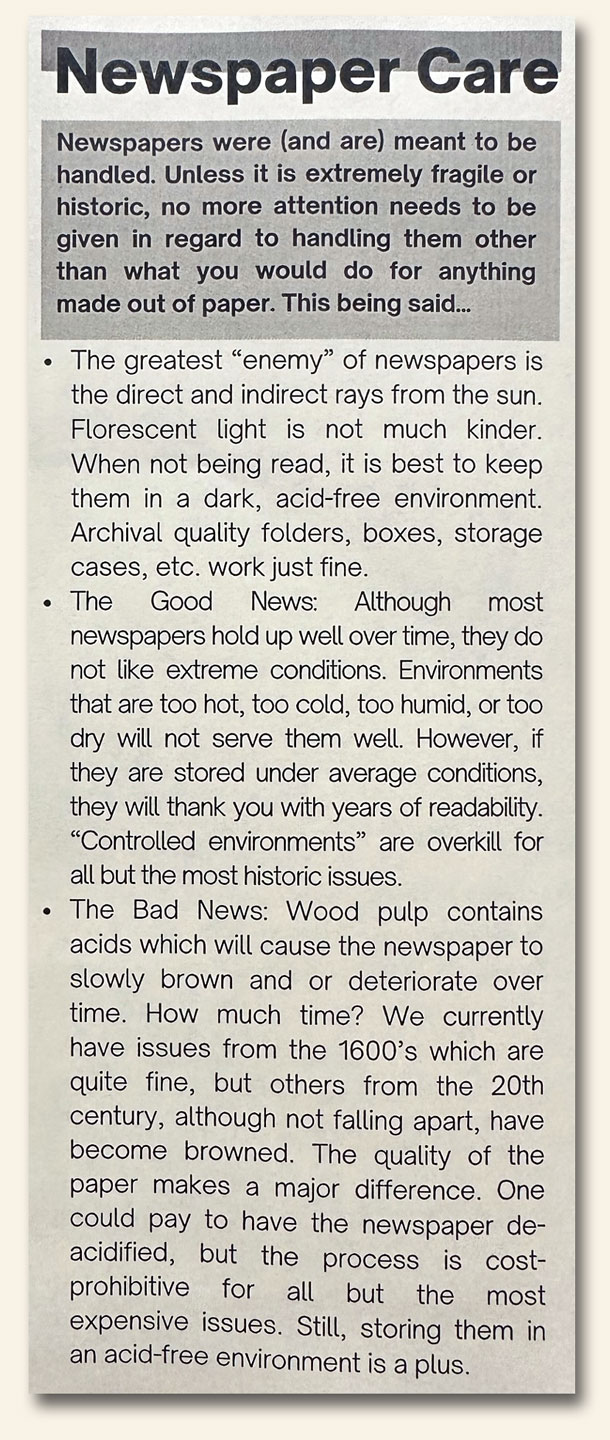
Additional information about the hobby can be found through this Blog and on the Rare Newspapers’ website.
“Collecting Newspapers – The Basics” (Part II) – What to Expect…
December 4, 2023 by GuyHeilenman · Leave a Comment
We, (Timothy Hughes Rare & Early Newspapers), have been collecting and offering old and historic newspapers to the collecting community since 1976 (Tim’s first purchase was in 1975). For those who are either unfamiliar with or new to this amazing hobby, today we are kicking off a series of posts, “Collecting Newspapers – The Basics”, to serve en masse as a Primer for those interested in learning more about the collectible. This is the 2nd installment. Enjoy.

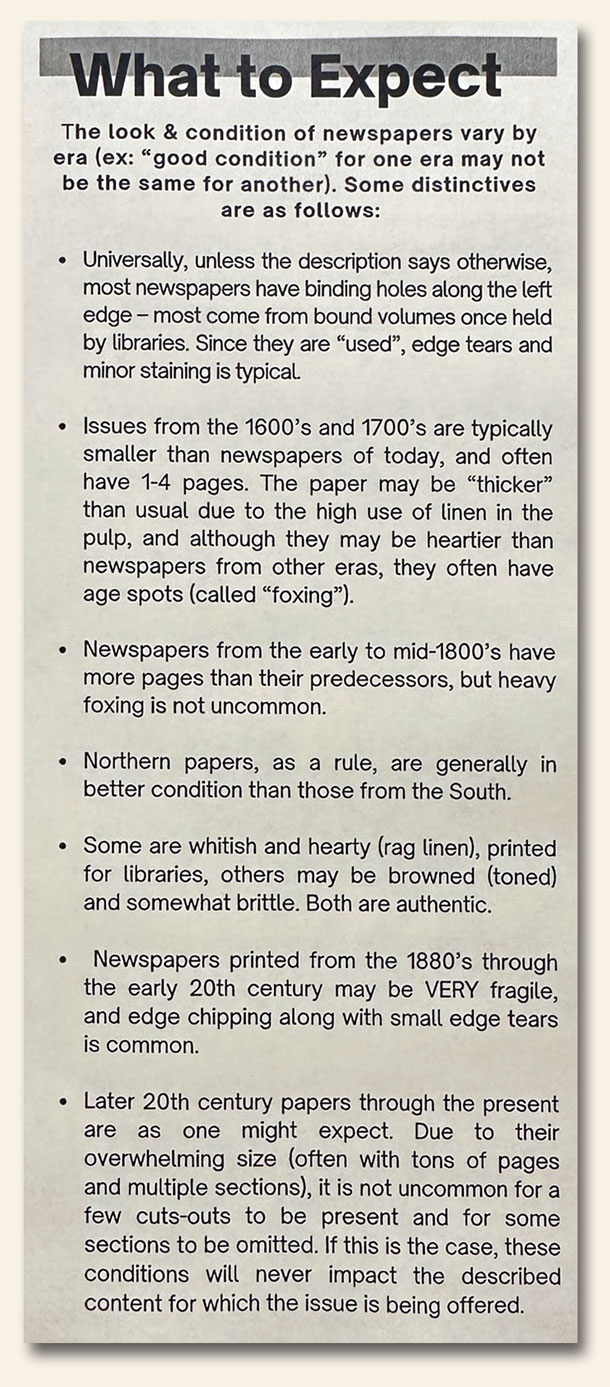
Additional information about the hobby can be found through this Blog and on the Rare Newspapers’ website.
“Collecting Newspapers – The Basics” (Part I) – Eras, Topics, and Titles…
November 27, 2023 by GuyHeilenman · Leave a Comment
We, (Timothy Hughes Rare & Early Newspapers), have been collecting and offering old and historic newspapers to the collecting community since 1976 (Tim’s first purchase was in 1975). For those who are either unfamiliar with or new to this amazing hobby, today we are kicking off a series of posts, “Collecting Newspapers – The Basics”, to serve en masse as a Primer for those interested in learning more about the collectible. The first installment (below) may appear to be a bit self-serving, but the heart behind it is simply to let seekers know the span of topics and types of newspapers which can be found. Enjoy.

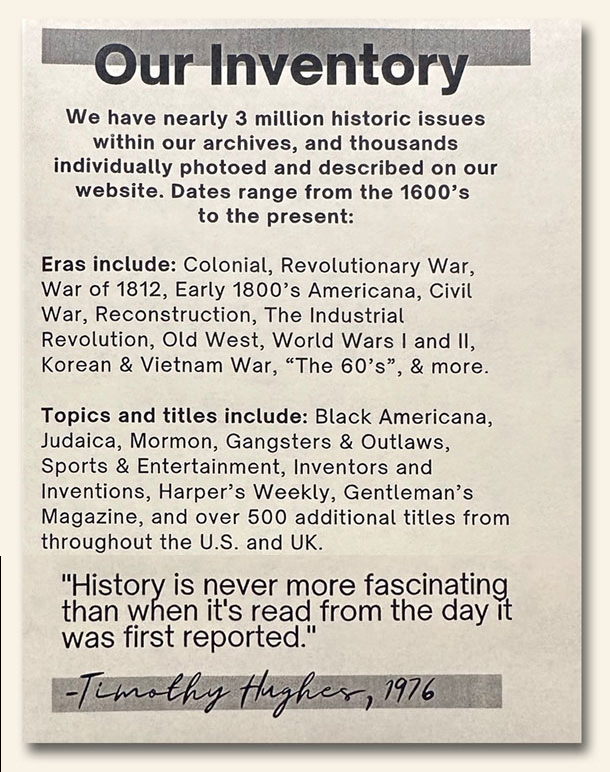
Additional collecting themes can be found through this Blog and on the Rare Newspapers’ website.
Collecting Rare & Early Newspapers… on a budget…
October 24, 2022 by GuyHeilenman · Leave a Comment
People who collect stamps… like stamps, collect trains… like trains, collect coins… like coins, collect classic cars… like classic cars, etc.. However, those who collect rare & early newspapers may have the collecting bug for Colonial America, the American Revolution, the Civil War, the Old West, sports, elections, inventions, early flight, tragedies, famous death reports, incredible achievements, illustrated ads of new products as they developed over time, beautiful wood-cut prints from famous artists and illustrators, the progress of civil rights and suffrage from the 1700’s through the present, … – oh, and articles, illustrations and/or ads related to stamps, trains, coins, classic cars and other popular collectibles. They may also simply value history and appreciate viewing events through the eyes of those who experienced them first had.
Of course it’s always best to enter a specific collectible before it becomes over-saturated, exploited, or over-priced, but most collectors arrive on the scene when the prices are either too high, or the value of the collectible is starting to decline.
In contrast, while there are several collectible newspapers priced in the $10,000 to $750,000+ range, many can still be obtained “on the cheap”. It is with this in mind one of our staff decided to create a brief video highlighting a few items priced under $50. In fact, there are well over 15,000 such items available on the RareNewspapers.com website. Please enjoy:

Collecting Old/Historic Newspapers: The 1600s & 1700s…
March 24, 2022 by GuyHeilenman · Leave a Comment
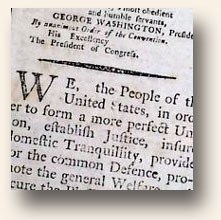 At Timothy Hughes Rare & Early Newspapers (rarenewspapers.com), we are often asked what types of “old Newspapers” are worth collecting. One of the beauties of the hobby is that the possibilities are endless. While we have our own preferences, once a month we will simply direct readers of the History’s Newsstand blog to an era, theme, topic, etc. for which our collector friends have expressed interest. This month’s focus is shown below. Feel free to email me at guy@rarenewspapers.com with your own collecting preference/s. Perhaps one day we’ll feature it/them as well.
At Timothy Hughes Rare & Early Newspapers (rarenewspapers.com), we are often asked what types of “old Newspapers” are worth collecting. One of the beauties of the hobby is that the possibilities are endless. While we have our own preferences, once a month we will simply direct readers of the History’s Newsstand blog to an era, theme, topic, etc. for which our collector friends have expressed interest. This month’s focus is shown below. Feel free to email me at guy@rarenewspapers.com with your own collecting preference/s. Perhaps one day we’ll feature it/them as well.
The 1600s and 1700s
Collecting Old/Historic Newspapers: The Revolutionary War…
March 17, 2022 by GuyHeilenman · Leave a Comment
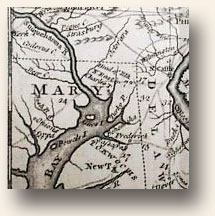 At Timothy Hughes Rare & Early Newspapers (rarenewspapers.com), we are often asked what types of “old Newspapers” are worth collecting. One of the beauties of the hobby is that the possibilities are endless. While we have our own preferences, once a month we will simply direct readers of the History’s Newsstand blog to an era, theme, topic, etc. for which our collector friends have expressed interest. This month’s focus is shown below. Feel free to email me at guy@rarenewspapers.com with your own collecting preference/s. Perhaps one day we’ll feature it/them as well.
At Timothy Hughes Rare & Early Newspapers (rarenewspapers.com), we are often asked what types of “old Newspapers” are worth collecting. One of the beauties of the hobby is that the possibilities are endless. While we have our own preferences, once a month we will simply direct readers of the History’s Newsstand blog to an era, theme, topic, etc. for which our collector friends have expressed interest. This month’s focus is shown below. Feel free to email me at guy@rarenewspapers.com with your own collecting preference/s. Perhaps one day we’ll feature it/them as well.
The Revolutionary War
March through the years via the lens of Rare & Early Newspapers…
March 6, 2020 by GuyHeilenman · 4 Comments
 Walk with us back through time to see what noteworthy, historic and collectible events occurred during the month of February. In so doing, we hope you’ll agree: “History is never more fascinating than when it’s read from the day it was first reported.”
Walk with us back through time to see what noteworthy, historic and collectible events occurred during the month of February. In so doing, we hope you’ll agree: “History is never more fascinating than when it’s read from the day it was first reported.”
March Through Time
February through the years via the lens of Rare & Early Newspapers…
February 10, 2020 by GuyHeilenman · Leave a Comment
 Walk with us back through time to see what noteworthy, historic and collectible events occurred during the month of February. In so doing, we hope you’ll agree: “History is never more fascinating than when it’s read from the day it was first reported.”
Walk with us back through time to see what noteworthy, historic and collectible events occurred during the month of February. In so doing, we hope you’ll agree: “History is never more fascinating than when it’s read from the day it was first reported.”
February Through Time



